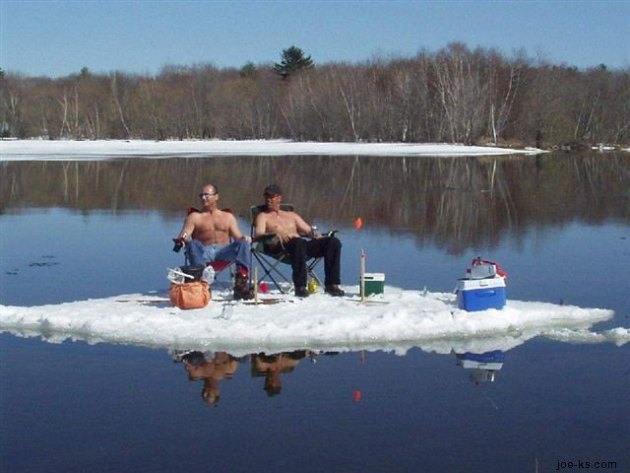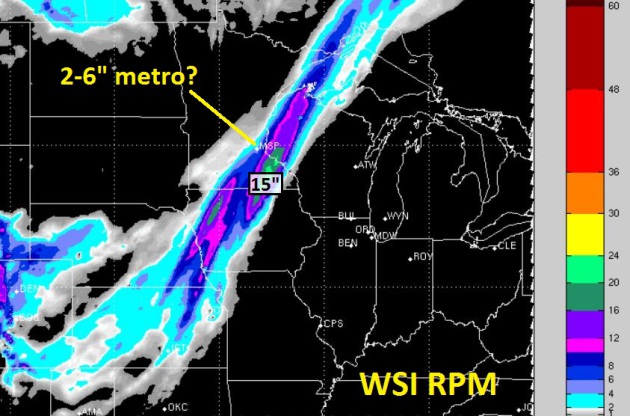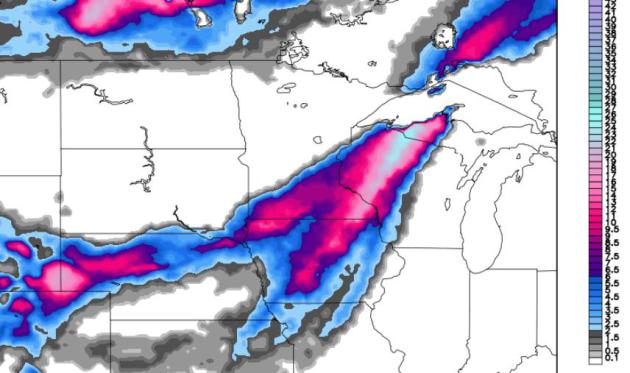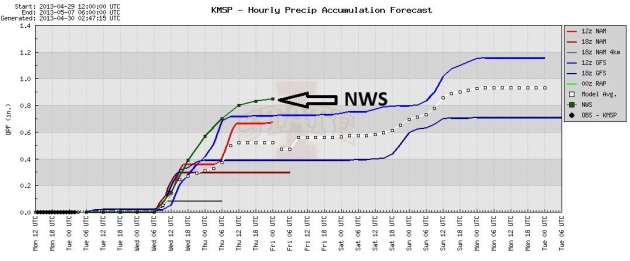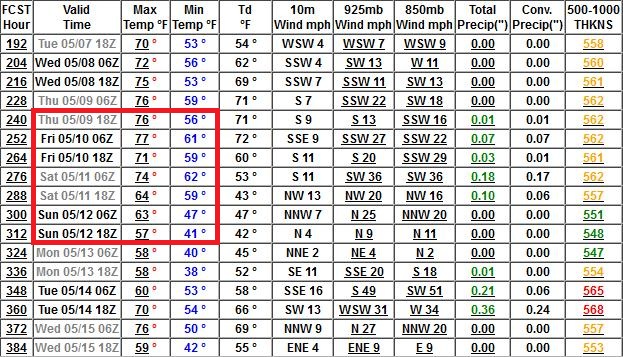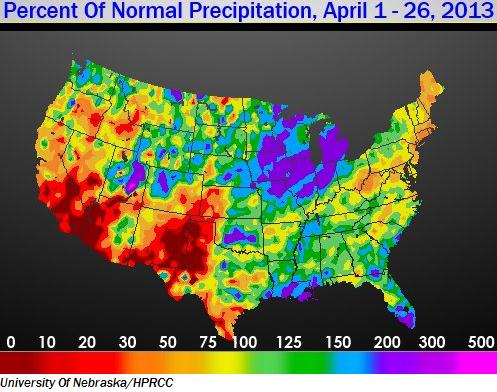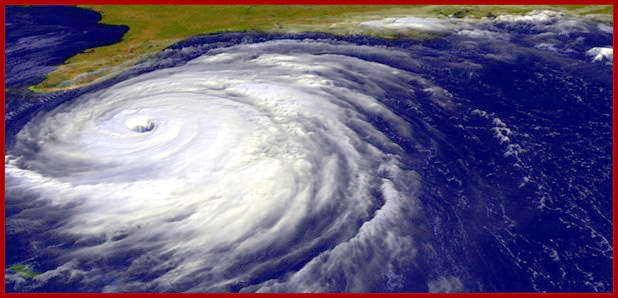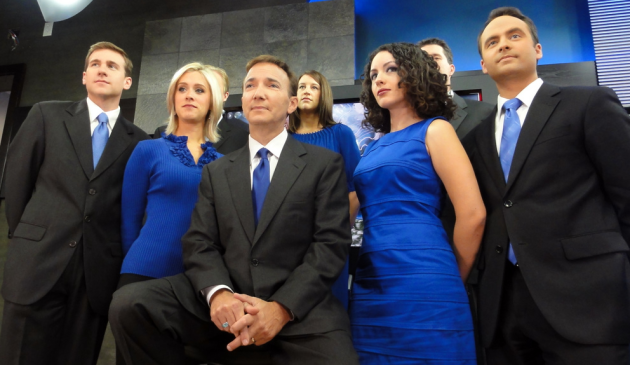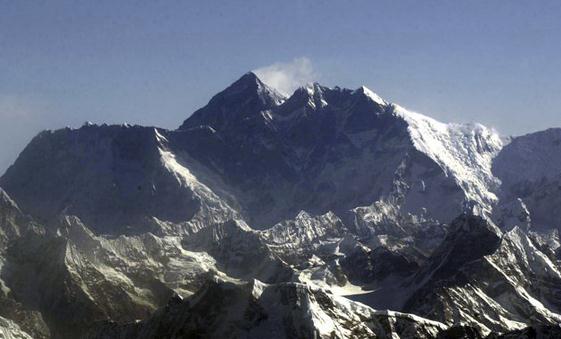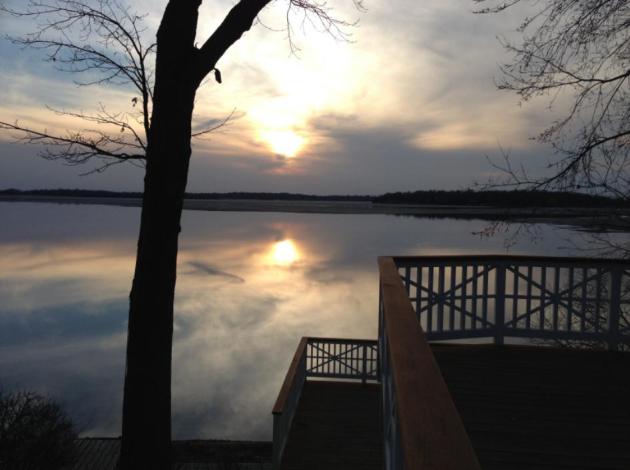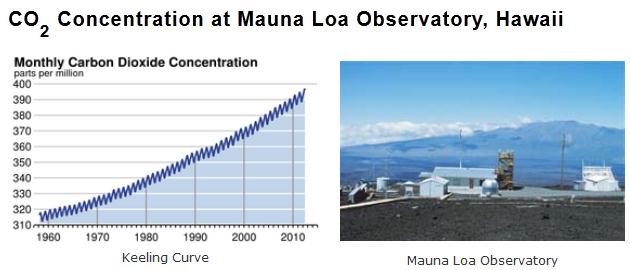1.24" precipitation predicted for Wednesday and Wednesday night in Minneapolis-St. Paul. Much of that will probably fall as sleet and snow.
2-6" sleet and snow possible by Wednesday night. Bufkit predicts 6.1" for MSP by Thursday morning.
3" old record for most snow from a single May storm (May 11-12, 1946).
Strike. I'm going on strike. I can't take it anymore.
Record May Snowfall?
One of the 15 meteorologists on my staff has
parents who returned from winter hibernation in Scottsdale back in early
April, thinking they'd be "out of the woods".
Hehehe.
I shouldn't laugh, but I can't help myself.
Three plowable snows and 18" later they are
reportedly thinking of moving to Arizona for good. Come to think of it,
our freakish un-spring may turn the rest of us us into snowbirds.
The most snow from a single May storm in the
Twin Cities? 3" in 1946. Hey, if the weather is crummy let's at least go
for a record. More boasting rights!
Here is what I know: Minnesotans lose their
stoic sense of humor when it snows on their green lawns. A cold front
arrives today; a cold rain likely on Wednesday. Amazingly, by Wednesday
night the lowest mile of the atmosphere will be cold enough for snow -
rain changes to wet snow Wednesday with a potential for a plowable
snowfall of 2-6" for parts of the Twin Cities metro, significantly more
over southeastern Minnesota. Good grief.
The same extreme pattern pumping moisture into
Minnesota, easing our drought, is also funneling harsh outbreaks of
winter chill southward. You can't have one without the other.
If it's any consolation long-range models show 60s, even 70s for the 2013 Fishing Opener.
I mean..what can possibly go wrong?
Historic May Snow Events In The Twin Cities. I was
really hoping not to have to share this information with you, but with a
nagging slush potential later this week I'm going to cover my
(Doppler) and include this excerpt from
The Minnesota Climatology Working Group: "
Snow
that falls in May is typically a novelty. The ground is usually too
warm by May to allow much of an accumulation. Looking at past records
for the Twin Cities, a trace of snow falls during the month of May
fairly frequently, with the last windswept flurries reported on May
1-2, 2005. If the snow manages to accumulate it is generally under an
inch and mostly on grassy surfaces. The most recent measureable Twin
Cities snow event was 0.3 inches on May 5, 1991. About once every 30
years or so, there is a snow event that is enough to cover newly
greened lawns and coat budding leaves. The last time there was a snow
event in May greater than an inch in the Twin Cities was on May 2, 1976
with 1.2 inches. The most that it has snowed in May in a single event
for the Twin Cities is three inches. This has happened on three
occasions: May 20, 1892, May 1, 1935 and May 11-12, 1946."
Top 10 May Snow Events At MSP. I know, this is one
Top 10 List you were hoping to never be subjected to. Will we make the
list later this week? Probably. Information courtesy of the
Twin Cities National Weather Service.
Almost Censored. Wednesday looks like the problem
day, temperatures aloft probably cold enough aloft for (mostly) snow.
Some of that snow will melt on contact with relatively mild lawns,
fields and roads, but wet, sloppy, gloppy snow may eventually accumulate
by Wednesday evening and night, and it may be enough to shovel and
plow, especially south/east of the Twin Cities. If it's 3" or more we'll
set a May snowfall record dating back to 1946. May I be excused?
NAM Solution.
I'm not buying it (yet), because it would smash old May snowfall records
for the Twin Cities, and temperatures aloft will be close to critical
by Wednesday night and Thursday; a degree or two warmer than predicted
aloft and we wind up with (mostly) rain. Will we see a slushy coating of
an inch or two? Probably. But 3-6"? Not convinced, not yet.
A Very Wet Week.
The ECMWF often gets a jump on trends, and then the U.S. models
eventually catch up. We'll see if that's the case this week - the
European model predicting over 3" liquid by Sunday, with a period of
potentially significant snow Thursday and Friday. Spring stages a modest
comeback by early next week.
U.S. Models - Not As Wet.
The local NWS office is predicting about .80" liquid by Thursday night,
but amounts may go higher by the weekend as Gulf moisture surges north,
pulled along by a temporarily stationary storm over the Central Plains.
A Fishing Opener Warm Front? I'm hesitant even
showing a 1-2 week extended outlook, because the pattern is still so
erratic (and extreme), and the cold bias we've witnessed since early
February is slow to fade. But GFS numbers shows 60s and 70s returning in
time for the opener, The Race For The Cure, and Mother's Day. For the
sake of mental health statewide, I hope the models are right.
Rapidly Fading Drought. At least that's the case
over most of the Midwest and Mississippi River Valley, where
precipitation since April 1 has been 1.5 to 3 times more than normal.
Meanwhile drought is deepening over the Southwest.
Backwards Spring. Check out some of these monthly
snowfall totals from Colorado - in many cases April has seen more snow
than February and March combined! Remarkable. Thanks to Earth Network's
Chad Merrill for passing this along.
Weathering The Irony Of The Sequester "Fix" To Air Travel Delays.
The head of the AMS, The American Meteorological Society, Dr. J.
Marshall Shepherd, talks about the recent flap over The Sequester and
air traffic delays in the larger scope of 24/7 access to reliable,
accurate weather information. Here's an excerpt from his post at
Facebook: "...
The
U.S. Department of Transportation finds that weather can be attributed
to 40% of all flight delays. If you want this in economic numbers,
ExecutiveTravelMagazine cites an FAA study that "calculated that delays
and cancellations from all causes cost passengers $16.7 billion a year.
That puts the price tag on weather-related schedule disruptions at
around $6.7 billion. "Further, it is clear that weather contributes to a
large percentage of aviation accidents and fatalities. Weather risks to
flight include thunderstorms, fog, clearn-air turbulence, snow/ice,
crosswinds, and wind shear. Many of these processes are not
well-understood, which means sequester pressures on research, travel to
scientific meetings, and journal access further complicate the safety of
our nation's air travelers in the long run. In summary, I find that
many people see the impact of the sequester on FAA furloughs and related
travel. However, many don't seem to stop and think about how critical
the national weather infrastructure and agencies are to air travel, yet
the continue to suffer under the weight of an ill-conceived sequester.
More alarming, weather information is vital to many facets of our daily
lives. Our weather enterprise is vital to life, property and commerce in
this country and piece-meal fixes are dangerous on many "fronts". Pun
intented...
Weather information that supports air travel does not come from the "weather fairy"...
Weather Service Faces Furloughs During Hurricane Season.
The first time there's a weather disaster and subsequent loss of life
that can be linked to a shortfall in staffing levels, God help us -
there will be screams of protest. Here's an excerpt from Florida's
SunSentinel: "...“
This
could have a detrimental effect on everybody’s public safety,” said
Bob Ebaugh, the steward in Miami for the National Weather Service
Employees Organization. “Once you start limiting staffing, you start
raising the potential for disaster.” He said furloughs could hamper the
NWS’ ability to predict wildfire and tornado conditions during the
spring and to pinpoint where storms might hit land during the summer.
Citing 250 vacancies throughout the Weather Service, Ebaugh said the
agency “saves money from not filling those positions, which just caused
more stress on the rest of the employees.” This mix of warnings and
assurances comes on the heels of an extraordinary year of storms,
flooding, blizzards and droughts — 11 separate billion-dollar disasters
in 2012, capped by superstorm Sandy. Weather-conscious Florida, where a
tourism economy depends on the great outdoors, has the most at stake
from any gaps in forecasting..." (Hurricane Floyd image courtesy of NASA).
Of Course You're Stressed - Just Look At You. Wait,
stress is bad for you? I have a t-shirt that reads "high on stress".
Launching a business in 2008, at the height of a recession, will do that
to you. Here's an excerpt from a story at
The L.A. Times: "
We all know the face of stress:
the clenched jaw, the furrowed brow, the intense stare. And, really,
it's not a bad look. We all do some of our best work under pressure.
Adrenaline and other stress hormones give us the kick start we need to
meet deadlines and generally get ahead in life. But when stress runs too
hot for too long, the look changes. People who are stressed for years
don't merely appear driven or focused. They look beaten down. In large
doses, stress can wear the body and speed up the clock on aging. The
wear and tear of stress can show up in every part of the body:
individual cells, bones, skin. You can even see it in photographs..."
Slaves To The Algorithm. The joys of data mining,
turning noise into something approximating intelligence, even when it
comes to which plot lines or actors to put in your upcoming film. Here's
a snippet of a fascinating story at
moreintelligentlife.com: "
There
are many reasons to believe that film stars earn too much. Brad Pitt
and Angelina Jolie once hired an entire train to travel from London to
Glasgow. Tom Cruise’s daughter Suri is reputed to have a wardrobe worth
$400,000. Nicolas Cage once paid $276,000 for a dinosaur head. He
would have got it for less, but he was bidding against Leonardo
DiCaprio. Nick Meaney has a better reason for believing that the stars
are overpaid: his algorithm tells him so. In fact, he says, with all
but one of the above actors, the studios are almost certainly wasting
their money. Because, according to his movie-analysis software, there
are only three actors who make money for a film. And there is at least
one A-list actress who is worth paying not to star in your next picture..."
Netflix CEO: "Over The Coming Decades...Internet TV Will Replace Linear TV".
In a world of infinite choice, where traditional TV is becoming
Internet-enabled - will viewers still watch linear TV? I hope so. Here's
an excerpt from
TVSpy: "...
In a letter to shareholders this week, Hastings lays out the 10 reasons
why Internet TV will continue to gain popularity, concluding that
“over the coming decades and across the world, Internet TV will replace
linear TV. Apps will replace channels, remote controls will disappear,
and screens will proliferate”:
People love TV content, and we watch over a billion hours a day
of linear TV. But people don’t love the linear TV experience where
channels present programs at particular times on non-portable screens
with complicated remote controls. Consumers click through a grid to
choose something to watch. DVRs and VOD add an on-demand layer, at the
cost of storage and increased complexity. Finding good things to watch
isn’t easy or enjoyable. While hugely popular, the linear TV channel
model is ripe for replacement..."
Nepal Officials Vow To Ensure Security On Everest After Fight. Because nothing gets the heart pounding faster than a rumble at 25,000 feet. Here's an excerpt from Reuters and
Yahoo News: KATHMANDU (Reuters) - "
Nepal
officials vowed on Monday to ensure the safety of climbers seeking to
scale Mount Everest after three European climbers were involved in a
fight with sherpa guides on their way to the peak of the world's
highest mountain. Three experienced climbers from Britain, Italy and
Switzerland were on route to camp three at 7,000 meters (22,965 feet)
on the 8,850 meters (29,035 feet) Everest summit when a brawl broke out
on Saturday with sherpas fixing their ropes. Witnesses said the
sherpas pelted the Europeans' tents with stones and punches were thrown..."
Photo credit: "
In this Tuesday, May 6, 2003 file photo,
Mount Everest, at 8,850-meter (29,035-foot), the world's tallest
mountain situated in the Nepal-Tibet border as seen from
an airplane. Days after four people died amid a "traffic jam" of
climbers scrambling to conquer Mount Everest, Nepal officials said a
similar rush up the world's tallest peak will begin soon, and there's
little they can do to control it." (AP Photo/Binod Joshi, File)
Climate Stories....
Greenhouse Gas Levels Highest In 3 Million Years.
400 ppm. The steady upward climb in greenhouse gases continues, with CO2
levels closing in on 400 parts per million. Here's an excerpt from
The Sydney Morning Herald:
"Carbon dioxide concentrations in the Earth's atmosphere are on the
cusp of reaching 400 parts per million for the first time in 3 million
years. The daily CO2 level, measured at the Mauna Loa Observatory in
Hawaii, was 399.72 parts per million last Thursday, and a few hourly
readings had risen to more than 400 parts per million. ''I wish it
weren't true but it looks like the world is going to blow through the
400 ppm level without losing a beat,'' said Ralph Keeling, a geologist
with the Scripps Institution of Oceanography in the US, which operates
the Hawaiian observatory. ''At this pace we'll hit 450 ppm within a few
decades...'' (Image above courtesy of Scripps Institute of
Oceanography).
British Winemakers Credit Climate Change For Boom In Bubbly Sales.The warming is showing up in unusual areas - good wine in England? That's a fairly recent development, as reported in
The Washington Post: "
Blessed
with soil similar to France’s Champagne region, vineyards in England
nevertheless produced decades of low-grade goop that caused nary a
Frenchman to tremble. But a Great British fizz boom is underway, with
winemakers crediting climate change for the warmer weather that has
seemed to improve their bubbly. Increasingly hospitable temperatures
have helped transplanted champagne grapes such as chardonnay and pinot
noir thrive in the microclimates of southern England, touching off a
wine rush by investors banking on climate change. Once considered an
oxymoron, fine English sparkling wine is now retailing for champagne
prices of $45 to $70 a pop. In recent years, dozens of vineyards have
sprouted in Britain’s burgeoning wine country, with at least one
traditional French champagne maker doing the once-unthinkable —
scooping up land to make sparkling wine in England..."
Photo credit above:
GRAHAM BARCLAY/BLOOMBERG NEWS. "Sparkling
wine undergoes an early fermentation process at the Ridgeview Wine
Estate in East Sussex, England. Warmer summers are producing wines
competitive with some from France."
What's Climate Scientist James Hansen's Legacy? Some answers in this story at
The Guardian; here's an excerpt: "
Just
a few weeks ago, one of the biggest names in climate science made one
of the biggest announcements possible. Dr. James (Jim) Hansen said that he will "retire" from his duties at NASA
to focus his energies elsewhere. This is a "retirement" that is
anything but. Dr. Hansen has made clear that he will become more
engaged in communicating climate science to the general public and he
will continue to carry out the high-quality work which he is known for.
What does this mean for climate science and the future of the Earth?
It is impossible to know now but instead of looking forward, I want to
shine a light on what Jim has done for climate science, what he
signifies to the larger public, and how he is viewed by current and
upcoming scientists..."
Image credit above: "
Climate scientist James Hansen is retiring from the NASA Goddard Institute for Space Studies." Photograph: Murdo Macleod.

